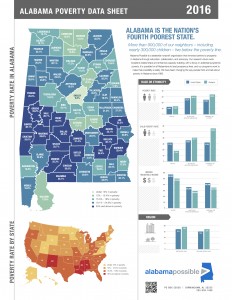 Alabama Possible’s 2016 Alabama Poverty Data Sheet highlights statewide poverty rates and data related to educational attainment, employment, and food security.
Alabama Possible’s 2016 Alabama Poverty Data Sheet highlights statewide poverty rates and data related to educational attainment, employment, and food security.
The 2016 Data Sheet reveals that 19.2 percent of Alabamians, or more than 900,000 people, live below the federal poverty line. Alabama’s poverty rate is higher than the national average of 15.5 percent.
Poverty and hunger are commonplace experiences in Alabama. Nearly all of us have experienced poverty or know someone who has. You can use the 2016 Data Sheet to guide your advocacy efforts and encourage deeper support for programs that effectively remove barriers to prosperity in Alabama.
Here’s what the latest data shows:
- Alabama is the fourth poorest state in the U.S., and 19.2 percent of Alabamians live below the federal poverty line, a noticeably larger percentage than the national average of 15.5 percent. The federal poverty line is $24,300 for a family of four.
- 19 of Alabama’s 67 counties have a poverty rate higher than 25 percent.
- Alabama has the fourth highest rate of child poverty in the country, and more than 300,000 Alabama children live in poverty. This is especially true among minorities, as African American children are twice as likely to live in poverty as white children, and Hispanic or Latino children are three times more likely to live in poverty as white children.
- Alabama has a notably high food insecurity rate at 18.8 percent.
- Every county in Alabama except Shelby County has a higher child food insecurity rate than the national average of 20.9 percent.
- Alabama has the fifth lowest Opportunity Index score in the country with 47.4 out of a possible 100. The Opportunity Index, a measurement developed by Measure of America and Opportunity Nation, takes into account a variety of conditions examined in the data sheet, including poverty and education, and provides a snapshot of economic mobility at the state and county levels.
Systemic poverty is a complex system with many interrelated components. Alabama Possible and our statewide partners like you advocate, collaborate, and educate so that all Alabamians can lead prosperous lives.
Join the conversation by sharing your stories and reactions in social media posts by tagging us at @alabamapossible or using the hashtag #beyondpoverty.
To access the 2016 Alabama Poverty Data Sheet, visit AlabamaPossible.org/PovertyDataSheet.